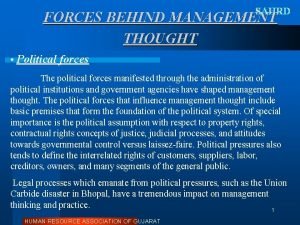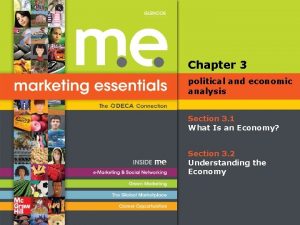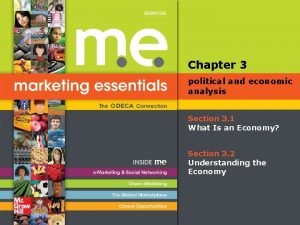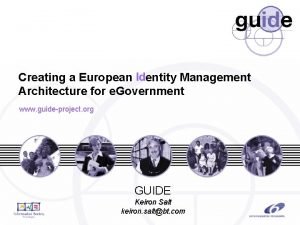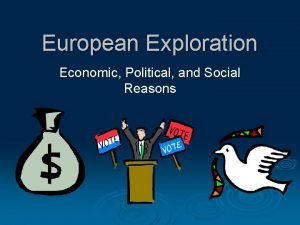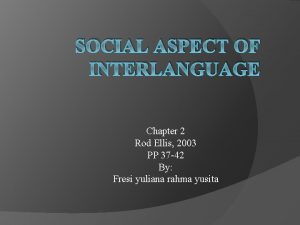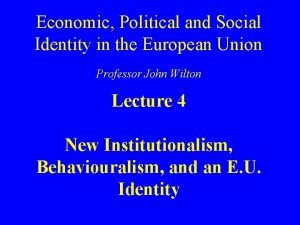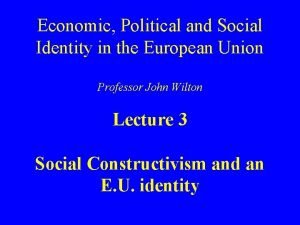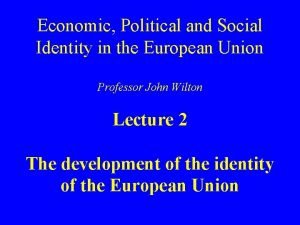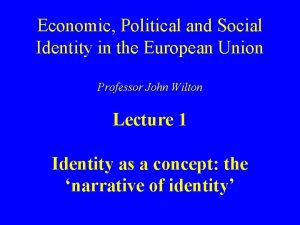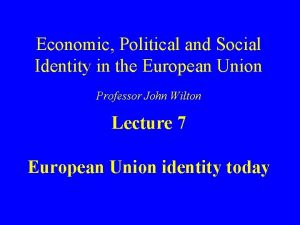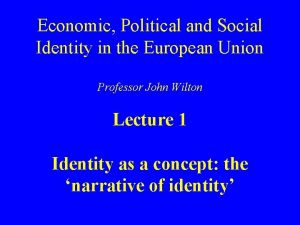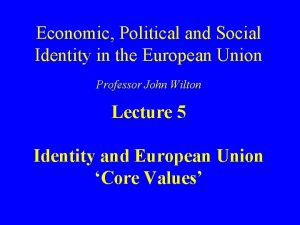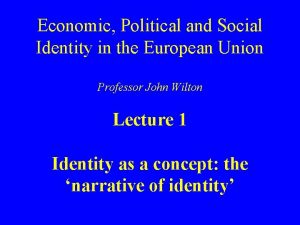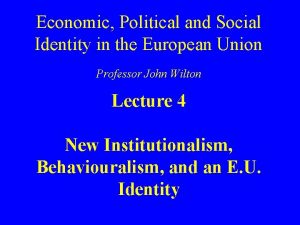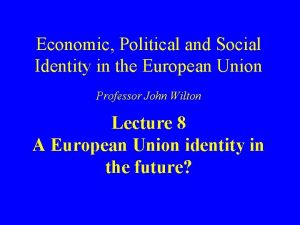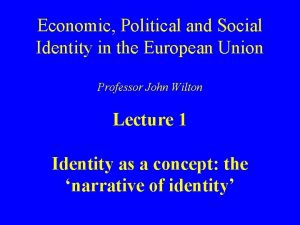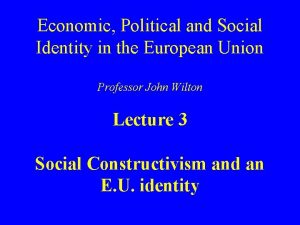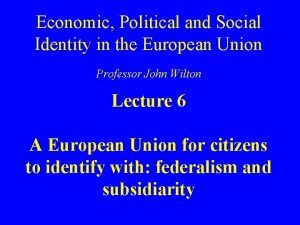Economic Political and Social Identity in the European














- Slides: 14

Economic, Political and Social Identity in the European Union Professor John Wilton Lecture 5 Identity and European Union ‘Core Values’

Lecture 5 Additional reading/source: Van Doth, J. W. (2009) “The ‘Good European Citizen’: Congruence and Consequences of Different Points of View”, European Political Science, Vol. 8, No. 2, pp. 175 -189

Lecture 5 1. Briefly identify some of the ‘core values’ that underpin the European Union 2. Examine ‘the culture’ of those values and beliefs – the ‘culture’ underpinning them 3. Has the acceptance of the ‘culture’ of those core values drawn the E. U. member states closer together – thereby drawing the E. U. citizens closer together, towards a common E. U. identity?

Lecture 5 1. The ‘core values’ that underpin the E. U. - a shared set of ideas and values based on liberal democracy; • • • democracy the rule of law peace and security economic stability and prosperity respect for human rights and minority rights diversity and tolerance

Lecture 5 - to promote and develop a European Union culture based upon the ‘European ideal’ (the ‘idea of Europe’) - the cultural representation of the ‘European idea’ is seen as the ‘cement’ that binds together the different groups of citizens in the E. U. member states – so that ‘cement’ ultimately produces a citizen E. U. identity

Lecture 5 2. The culture underpinning the values and beliefs of the ‘European idea’ “The world of culture cannot remain outside the process of completion of the big European internal market: that process demands the formation of a true European culture area” (European Commission Report, 1988)

Lecture 5 “It is an experiment whose results are of universal significance, an attempt to establish between States the same rules and codes of behaviour that enabled primitive societies to become peaceful and civilised” (Pascal Fontaine, A Citizen’s Europe, European Commission, 1993)

Lecture 5 “We are not forming coalitions between States but union among peoples” (Jean Monnet) - a ‘People’s Europe’

Lecture 5 In the past traditions such as: - Roman law; - Greek philosophy and science; - Christian theology - Renaissance and Enlightenment traditions; - have ‘travelled’ across the European continent to produce a ‘European culture-area’ or ‘family of cultures’

Lecture 5 “The idea of a man without a nation seems to impose a strain on the modern imagination … A man must have a nationality as he must have a nose and two ears. All this seems obvious, though, alas, it is not true. But that it should have come to seem so very obvious is indeed an aspect, perhaps the very core, of the problem of nationalism. Having a nation is not an inherent attribute of humanity, but it has now come to appear as such. ” (Ernest Gellner, 1983)

Lecture 5 3. An ‘imagined E. U. community’ based on common citizen identity? - ‘agents of European consciousness’ - forces and objects through which knowledge of the E. U. is embodied and communicated as a socio-cultural phenomenon - ‘actors’, actions, artefacts, bodies, institutions, policies and representations (symbols) that singularly or collectively engender awareness and promote acceptance of the ‘European idea’.

Lecture 5 ‘Agents of E. U. consciousness’ range from the abstract to the concrete; from: - E. U. institutions and civil servants - the Single Market and the Euro - the metric system of weights and measures - E. U. laws and regulations to: - educational exchanges - town-twinning - invented Euro-symbols and traditions - European Union history - the harmonisation of E. U. statistics by the Eurostat office

Lecture 5 “Nationalism is not the awakening of nation-states to self-consciousness; it invents them where previously they did not exist. ” (Ernest Gellner) - the emergence of the link between ‘imagining’ the State and nation, cultural politics and the formation of political identities - consciousness of citizen identity arises through the medium of culture and communication – the communication of that identity and what it means/represents

Lecture 5 - Symbols do not simply represent political reality, they actively create it. - ‘created’ public symbols for the E. U. , i. e. : - the E. U. flag, with circle of stars symbolising European unification - the E. U. anthem (’Ode to Joy’) - European Union passport - the Euro
 Forces behind management
Forces behind management Political economic
Political economic Puritans england
Puritans england Chapter 3 political and economic analysis
Chapter 3 political and economic analysis Chapter 3 political and economic analysis
Chapter 3 political and economic analysis European identity providers
European identity providers Growth and development conclusion
Growth and development conclusion Social identity map
Social identity map European exploration economic reasons
European exploration economic reasons Undelies
Undelies Stylistic continuum in interlanguage
Stylistic continuum in interlanguage Economic growth vs economic development
Economic growth vs economic development Economics unit 1 lesson 2 difficult choices
Economics unit 1 lesson 2 difficult choices Social thinking adalah
Social thinking adalah Social thinking social influence social relations
Social thinking social influence social relations
